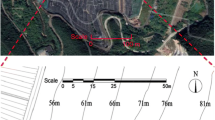Abstract
Two most common types of sewer systems are gravity sewer system and pressure sewer system. In last 25 years, a relatively new wastewater collection system called vacuum system got acceptance and popularity in certain circumstances (e.g., hilly and rocky terrains, areas with high groundwater table, unstable soil condition). Due to lack of comprehensive understanding and design procedure, very limited studies on vacuum sewer have been reported in the literature. This study complied a complete design procedure for vacuum system and attempted to compare and evaluate capital and operating costs of the vacuum sewer system against gravity counterpart. From the detailed designs of two systems for same areas, the vacuum system found relatively cheaper in terms of total construction and operation costs. The excavation cost for vacuum system is around one-fourth of the excavation cost for the gravity system. However, total manhole cost in gravity system is relatively cheaper (33 %) than the total cost of the similar components in vacuum system (inspecting valves, vacuum valves, division valves and connections). Other costs, like trench filling materials cost, labor cost, dewatering and safety measure costs are also less in vacuum system compared to the similar costs for the gravity system. Total energy cost for vacuum system is around 6.5 % less compared to the total energy cost for the gravity counterpart for same time period. Overall, vacuum system is around 30 % less expensive than gravity system.











Similar content being viewed by others
References
ATV-DVWK (2004) Worksheet: part 1: vacuum drainage outside of buildings. GFA, Apr 2004
Can I (2005) Simplified equations calculates head losses in commercial pipes. J Am Sci 1(1):1–3
City of Salem (1991) Sanitary sewer design standard. Department of public works, Oregon
City of Virginia Beach (2005) Design standard manual. Department of public utilities, City of Virginia Beach
Concrete Pipeline Design Association (2006) Technical design guide
EN-1091 (1996) European standard EN 1091: vacuum sewerage system outside the buildings
Frankel M (2009) Facility piping systems handbook: for industrial, commercial, and healthcare facilities. McGraw-Hill Professional, New York 1040
Islam MS (2007) Design, analysis and evaluation of vacuum sewer systems against gravity sewer systems. Master of science in hydroinformatics and water management, managed by EuroAquae consortium
Jinming D, Jingxuan Z (2006) Studies on frictional pressure drop of gas-non-Newtonian fluid two-phase flow in the vacuum sewers. Civ Eng Environ Syst 23(1):1–10 (Taylor & Francis)
Little CJ (2004) A comparison of sewer reticulation system design standards gravity, vacuum and small bore sewers. Water SA 30(5):137–144
Read GF (ed) (2004a) Development of sewerage rehabilitation. In: Sewers. Replacement and new construction. Butterworth-Heinemann, Oxford, pp 1–19. ISBN:9780750650830. doi:10.1016/B978-075065083-0/50002-5
Read GF (ed) (2004b) New construction. In: Sewers. Replacement and new construction. Butterworth-Heinemann, Oxford, pp 20–46. ISBN:9780750650830. doi:10.1016/B978-075065083-0/50002-5
ROEVAC (2000) Vacuum sewer systems planning guidelines. Germany
Schluff RH (2003) Sewerage system technology in upheaval. University Stuttgart, Germany
Skillman E (1979) Design criteria for vacuum wastewater transfer systems in advanced base applications. Civil Engineering Lab (Navy), Port Hueneme
Sullivan JF, Harrington B, Johnson S, Bergman KA (2003) Advent of vacuum sewers in New England. J N Engl Water Environ Assoc 37(2):145–162
Tang J, Li M, Wang BZ (2013) An introduction to vacuum sewerage system and its applications in China. Adv Mater Res 610–613:2467–2471
Tchobanoglous G (1989) Wastewater engineering: collection and pumping of wastewater. McGraw-Hill Book Company, New York
The Corporation of the City of London (2003) Sanitary sewer collection systems. Environmental and Engineering Services Department
USEPA (1991) Manual—alternative wastewater collection systems. Risk Reduction Engineering Laboratory, Cincinnati
Vickridge I (2004) Aspects of sewer design. In: Read GF (ed) Sewers. Replacement and new construction. Butterworth-Heinemann, Oxford, pp 116–131
Acknowledgments
The author is grateful to the EuroAquae Consortium, funded by European Union, for supporting this study as a part of author’s Master of Science degree in hydroinformatics and water management. The author would like to express sincere gratitude to Dr. Vedrana Kutija and Mr. Vassilis Glenis of Newcastle University for their assistance in data collection and analysis.
Author information
Authors and Affiliations
Corresponding author
Rights and permissions
About this article
Cite this article
Islam, M.S. Comparative evaluation of vacuum sewer and gravity sewer systems. Int J Syst Assur Eng Manag 8, 37–53 (2017). https://doi.org/10.1007/s13198-016-0518-z
Received:
Published:
Issue Date:
DOI: https://doi.org/10.1007/s13198-016-0518-z



